I've created a basic sample app with Xamarin.Forms, where I tried to repoduce a UI like Twitter or Instagram with:
- a MasterDetail page as main page, where the default "hamburger" icon is replaced by a custom icon
- a "bottom" TabbedPage as detail of the MasterDetail page
- a control allowing to implement top Tabs in the TabbedPage
- ContentPages that are hosted in NavigationPage for each tab of the TabbedPage
So, the the pages architecture of my app looks like this:
|-- MasterDetailPage
..|--TabbedPage
....|-- NavigationPage
......|-- ContentPage
For achieving this, I've used:
- the Naxam BottomTabedPage, to implement "bottom" TabbedPage on Android (like BottomNavigationView)
- the Syncfusion SfTabView control to implement the "top" Tabs
- a custom renderer to manage the use of custom icon as "hamburger" icon on the main level, and the "arrow" icon on the childs levels
This renderer looks like this:
public class CustomNavigationPageRenderer : MasterDetailPageRenderer
{
protected override void OnLayout(bool changed, int l, int t, int r, int b)
{
base.OnLayout(changed, l, t, r, b);
var toolbar = FindViewById<Android.Support.V7.Widget.Toolbar>(Resource.Id.toolbar);
for (var i = 0; i < toolbar.ChildCount; i++)
{
var imageButton = toolbar.GetChildAt(i) as ImageButton;
var drawerArrow = imageButton?.Drawable as DrawerArrowDrawable;
if (drawerArrow == null)
continue;
bool displayBack = false;
var app = Xamarin.Forms.Application.Current;
//var navPage = ((app.MainPage.Navigation.ModalStack[0] as MasterDetailPage).Detail as NavigationPage);
var detailPage = (app.MainPage as MasterDetailPage).Detail;
if (detailPage.GetType() == typeof(BottomTp.Views.NaxamMainPage))
{
var tabPage = detailPage as BottomTabbedPage;
var curPage = tabPage.CurrentPage;
var navPageLevel = curPage.Navigation.NavigationStack.Count;
if (navPageLevel > 1)
displayBack = true;
}
if (!displayBack)
ChangeIcon(imageButton, Resource.Drawable.icon);
}
}
private void ChangeIcon(ImageButton imageButton, int id)
{
if (Android.OS.Build.VERSION.SdkInt >= Android.OS.BuildVersionCodes.Lollipop)
imageButton.SetImageDrawable(Context.GetDrawable(id));
imageButton.SetImageResource(id);
}
}
This works well, but there is a last problem when I "return" to the main page:
- there is the default transition animation from arrow to "hamburger" icon
- after this, the "hamburger" icon is replaced by my custom icon
Here is a short animation to illustrate this issue:
Is there a way to deactivate this animation? How could I fix this?
